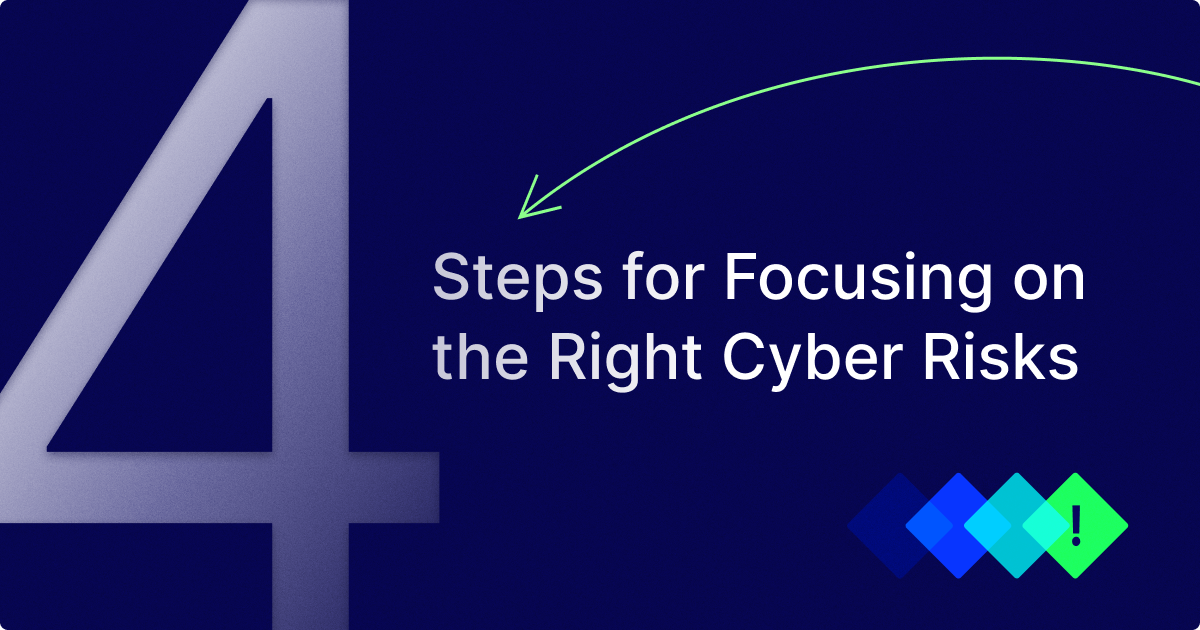With bad actors constantly testing new and creative ways to compromise our systems and make off with sensitive information and assets, cybersecurity risk management can feel like an uphill battle. These threats are coming at us from every angle, every day, at an increasingly faster clip — and risk leaders are expected to fend them off with fewer resources than ever.
Anticipating, preventing, and mitigating the most severe cybersecurity outcomes (Think: irreparable reputational damage from a breach that affects thousands of your customers) depends on your team’s ability to separate the signal from the noise and prioritize addressing your organization’s truly critical cyber risks.
Here are four steps for making sure you’re paying the right amount of attention to the right cyber risks.
1. Identify your cyber risks
You can’t start prioritizing your most pressing cybersecurity threats if you don’t know what your organization’s cyber risk landscape looks like. Unfortunately, most organizations face so many different risks that this is where things can quickly become overwhelming.
Using a cybersecurity risk management framework, like SOC2, NIST, or ISO 27005, is a great way to get a handle on things right from the outset. These frameworks are proven sets of standards, policies, and procedures for protecting your company’s systems and data from cybersecurity threats. They include methods for getting a full picture of where your organization’s vulnerabilities exist, so you can start to evaluate which need the most attention.
An added bonus of using and complying with one or more of these frameworks: You’ll be able to quickly and easily prove to current or prospective customers, your board, and cyber insurers that you’re taking adequate steps to protect your information. This can be a competitive differentiator and a money-saver.
2. Quantify and rank your risks
With a clear understanding of your cyber risk landscape, you can now start tying risks to impact to determine which pose the most serious threats. You’ll want to assess each risk based on their:
- Likelihood to occur: How likely is it that your organization will face this threat?
- Potential impact: How much does your organization stand to lose as a result of an occurrence?
- Risk velocity: How fast can you expect the identified risk to affect your organization?
At a basic level, you’ll want to develop a risk matrix that assigns a severity score based on their individual likelihood and impact — either by using a red-yellow-green or one through five ranking system – to each of your cyber risks.
With this data in hand, you’ll be able to much more easily identify which risks warrant the most attention.
3. Use advanced prioritization methods
Those basic risk matrices are handy tools for getting a basic understanding of the risks your business faces, but ensuring you’re focused on handling the most important risks first requires an even deeper level of analysis.
At this point, you’ll need to use a risk quantification method that allows you to attribute financial or other business impact to the risks that fall into the more severe categories from your last analysis. Methods like Monte Carlo simulation or the Open FAIR™ model work well for this purpose.
Being able to pin a monetary value to your risks will allow you to take that information to leadership and more easily secure buy-in for doing what is necessary to address or respond to them.
4. Implement a risk-based mitigation strategy
Now that you know which risks you need to focus on first, it’s time to take some action. You’ll need to decide what sort of treatment each of the risks requires:
- Acceptance: If your analyses show that a particular risk doesn’t have the potential to cause much harm for your business, you can simply accept it. For your most critical cybersecurity risks, though, this is most likely not an option.
- Avoidance: This strategy involves simply not engaging in activities that could expose you to a specific risk. If you’ve determined that this risk could take an unacceptably high toll on your business and you can tolerate the potential opportunity cost of foregoing the associated activity, then you can avoid the risk altogether.
- Transference: Transferring your risk to a third party, like an insurer, is a compromise between acceptance and avoidance. This lets you continue to engage in and reap the benefits of the activity that exposes you to the risk while ensuring you can recoup some losses if a breach or other incident occurs. However, this method will not protect you from the reputational damage associated with the incident.
- Mitigation: Mitigating cyber risks involves putting some sort of control in place. This could take the form of implementing multi-factor authentication across your organization, having a policy management process in place, taking stock of and consolidating your tech stack, and ensuring all of your software is up to date.
Don’t just “check the box”
Remember: threat actors never rest, and neither should you. Don’t just check the boxes on a few risk management frameworks, assign your risks a color or a number, then call it a day. Always be re-evaluating your threat landscape as it evolves, testing your controls to make sure they’re working, and educating each and every member of your organization about the importance of staying vigilant.
Click here to learn more about how LogicGate Risk Cloud’s Cyber Risk and Controls Compliance Solution can help you prioritize your cyber risk.
